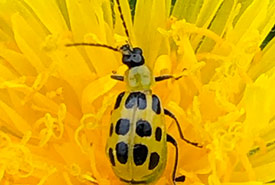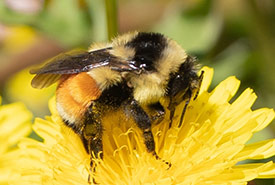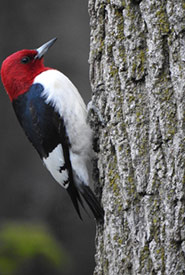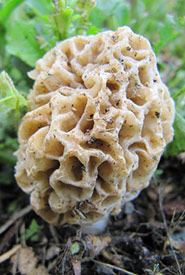Smile for the camera

Spotted cucumber beetle (Photo by Todd Norris, CC BY-NC 4.0)
Learn how to take more valuable photos for iNaturalist to help get them rated as observations that will contribute to wider research and citizen science.
It is becoming easier than ever to participate in citizen science using apps like iNaturalist. Led by the Canadian Wildlife Federation and partners, iNaturalist Canada aims to empower people to get outside and capture images and sounds of species they encounter. Once you submit an observation, it is verified by another user and becomes classified as “research grade” (meaning its identification is accurate enough to contribute to research observations). These data are then sent to the Global Biodiversity Information Facility to help scientists find and use information that has been properly verified. Here are some tips and tricks to help get your sightings verified. Remember, never disturb or handle animals, and avoid trampling plants, fungi and lichens. Stay on trails and observe animals quietly from a distance.
General best practices
Use these simple practices to get good observations every time:
Cropping
Crop your photos so that the focus is on the species itself.
Focus
Get as much of the subject in focus as possible.
Create your own macro lens
Hold a jeweler’s loupe up to your smartphone camera.
Multiple views
Take photos of the same individual from different angles to show different features, and combine them into a single observation. Go macro (zoom in) if you can; the more detail the better. A photo showing the habitat or what the plant is growing on is helpful.
Species-specific tips
Not every organism is easy to photograph, or easy to identify from photographs.
Beetles, bugs and crabs
The most important angle is from above, so that its key features can be seen. Then try for the side, front and underside, if possible.

Tri-coloured bumble bee (Photo by sylviejubinville49, CC BY-NC 4.0)
Bumble bees, flies and leafhoppers
Make sure the head and abdomen are visible, so go for the side shot.
Butterflies and moths
Take the shot from both the underside and the top side of its wings.
Dragonflies
Photograph from the side, showing the thorax, if possible. Both eye colour and tail structure can be crucial in identifying dragonflies and damselflies.
Spiders
Photograph the shape of the web, if present, and note its surroundings. Use your macro lens for the top and underside of the spider, as well as its face head-on.
Amphibians
Shoot these from the side, so there’s a clear view of the side of the face, and from the top down. Go macro on any scales. Do not handle animals, unless you are moving them to safety, such as off the road.

Red-headed woodpecker (Photo by simdav, CC BY-NC 4.0)
Birds and mammals
Photograph the entire body and ensure the face is visible. Crop the photograph so the animal takes up most of the image. Do not spend too long photographing a bird or animal; observe from a distance and move away. If the animal becomes agitated, move away immediately.
Mosses and fungi
Photograph the overall shape and what it is growing on. Try to get shots of any fruiting bodies or sporing capsules.
Flowering plants
Capture the habitat and overall appearance, including the head of the flower and its leaves, fruit or cones. Photograph the overall form of the plant, and take another shot showing the arrangement of the leaves and the structure of the flowers or fruits. When photographing grass, capture the seed head, leaf tips and blades.

Yellow morel (Photo by john_jacob, CC BY-NC 4.0)
Learn more at iNaturalist.ca! The iNaturalist Photo Guide was overseen by Kate McKeown on behalf of the co-organizers of the BC Parks iNaturalist program, Brian Starzomski and John Reynolds, with input from naturalists at the Royal BC Museum, BC Conservation Data Centre and others from across British Columbia.
This story originally appeared in the summer 2021 issue of the Nature Conservancy of Canada Magazine. To learn more about how you can receive the magazine, click here.
Explore additional content from our summer issue here >



